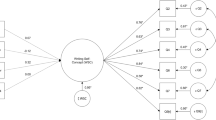Abstract
The purpose of this study was to determine the effects of self-graphing on the writing of 3 fourth grade students with high-incidence disabilities. Measures of written expression included total number of words written and number of correct word sequences. During intervention, students self-graphed their total number of words written in response to a timed story starter. A functional relationship was found between the self-graphing intervention and the total words written and number of correct word sequences. Implications for future research and practice are discussed.


Similar content being viewed by others
References
AIMSweb (2007). AIMSweb growth table: Written expression. Eden Prairie, MN: EdFormation, Inc. http://www.aimsweb.com/ norms/written_espression.htm. Retrieved 2 Feb 2007.
Brooks, A., Todd, A. W., Tofflemoyer, S., & Horner, R. H. (2003). Use of functional assessment and a self-management system to increase academic engagement and work completion. Journal of Positive Behavior Interventions, 5, 144–152.
Cooper, J. O., Heron, T. E., & Heward, W. L. (2007). Applied behavior analysis. Columbus: Merrill Publishing Company.
Deno, S. L., Marston, D., & Mirkin, P. (1982). Valid measurement procedures for continuous evaluation of written expression. Exceptional Children, 48, 368–371.
DiGangi, S. A., Maag, J. W., & Rutherford, R. B. Jr. (1991). Self-graphing of on-task behavior: Enhancing the reactive effects of self-monitoring on on-task behavior and academic performance. Learning Disability Quarterly, 14, 221–229.
Dodds, T., & Chislett, M. (1999). Adventures in language: level II fun with language. New York: J/P Associates.
Englert, C. A., Raphael, T. E., Anderson, L. M., Anthony, H. M., Fear, K. L., & Gregg, S. L. (1988). A case for writing intervention: Strategies for informational text. Learning Disabilities Focus, 3(2), 98–113.
Espin, C. A., Shin, J., Deno, S. L., Skare, S., Robinson, S., & Benner, B. (2000). Identifying indicators of written expression proficiency for middle school students. The Journal of Special Education, 34, 140–153.
Gersten, R., & Baker, S. (2001). Teaching expressive writing to students with learning disabilities: A meta-analysis. The Elementary School Journal, 101, 251–272.
Graham, S., Harris, K. R., MacArthur, C. A., & Schwartz, S. (1991). Writing and writing instruction for students with learning disabilities: Review of a research program. Learning Disability Quarterly, 14, 89–114.
Gunter, P. L., Miller, K. A., Venn, M. L., Thomas, K., & House, S. (2002). Self-graphing to success: Computerized data management. Teaching Exceptional Children, 35(2), 30–34.
Harris, K. R., Graham, S. R., McElroy, K., & Hamby, R. S. (1994). Self-monitoring of attention versus self-monitoring of performance: Replication and cross task comparison studies. Learning Disability Quarterly, 17, 121–139.
Houck, C. K., & Billingsley, B. S. (1989). Written expression of students with and without learning disabilities: Differences across the grades. Journal of Learning Disabilities, 22, 561–567.
Kasper-Ferguson, S., & Moxley, A. (2002). Developing a writing package with student graphing of fluency. Education and Treatment of Children, 25, 249–267.
Levendoski, L. S., & Cartledge, G. (2000). Self-monitoring for elementary school children with serious emotional disturbances: Classroom applications for increased academic responding. Behavioral Disorders, 25, 211–224.
Li, H., & Hamel, C. M. (2003). Writing issues in college students with learning disabilities: A synthesis of the literature from 1990 to 2000. Learning Disability Quarterly, 26, 29–46.
Martin, K. F., & Manno, C. (1995). Use of a check-off system to improve middle school students’ story compositions. Journal of Learning Disabilities, 28, 139–150.
Moxley, R. A., & Lutz, P. A. (1995). Self-recorded word counts of freewriting in grades 1–4. Education & Treatment of Children, 18, 138–158.
Newcomer, P. L., & Barenbaum, E. M. (1991). The written composing ability of children with learning disabilities: A review of the literature from 1980–1990. Journal of Learning Disabilities, 24, 578–593.
Persky, H. R., Daane, M. C., & Jin, Y. (2002). The nation’s report card: Writing 2002. Washington, DC: National Center for Education Statistics. http://www.nces.ed.gov/pubsearch/pubsinfo.asp?pubid=2003529. Retrieved 2 Feb 2007.
Powell-Smith, K. A., & Shinn, M. R. (2004). Administration and scoring of written expression curriculum-based measurement (WE-CBM) for use in general outcome measurement. Eden Prairie: EdFormation, Inc.
Rooney, K., Polloway, E. A., & Hallahan, D. P. (1985). The use of self-monitoring procedures with low IQ learning disabled students. Journal of Learning Disabilities, 18, 384–389.
Shimabukuro, S. M., Prater, M. A., Jenkins, A., & Edelen-Smith, P. (1999). The effects of self-monitoring of academic performance on students with learning disabilities and ADD/ADHD. Education and Treatment of Children, 22, 397–414.
Tindal, G., & Parker, R. (1991). Identifying measures for evaluating written expression. Learning Disabilities Research & Practice, 6, 211–218.
Trammel, D. L., Schloss, P. J., & Alper, S. (1994). Using self-recording, evaluation, and graphing to increase completion of homework assignments. Journal of Learning Disabilities, 27, 75–81.
Videen, J., Deno, S. L., & Marston, D. (1982). Correct word sequences: A valid indicator of writing proficiency in written expression (Research Rep. No. 84). Minneapolis: University of Minnesota, Institute for Research on Learning Disabilities.
Wechsler, D. (1991). Wechsler individual achievement test, 2nd ed. (WIAT-II). The Psychological Corporation, 2001.
Wechsler, D. (2001). Wechsler intelligence scale for children, 3rd. ed. (WISC-III). The Psychological Corporation.
Weissenburger, J. W., & Espin, C. A. (2005). Curriculum-based measures of writing across grade levels. Journal of School Psychology, 43, 153–169.
Wolf, M. M. (1978). Social validity: The case for subjective measurement or how applied behavior analysis is finding its heart. Journal of Applied Behavior Analysis, 11, 203–214.
Woodcock, R. W., McGrew, K. S., & Mather, N. (2001). Woodcock-Johnson tests of achievement (WJ III). Itasca: Riverside Publishing.
Author information
Authors and Affiliations
Corresponding author
Rights and permissions
About this article
Cite this article
Stotz, K.E., Itoi, M., Konrad, M. et al. Effects of Self-graphing on Written Expression of Fourth Grade Students with High-Incidence Disabilities. J Behav Educ 17, 172–186 (2008). https://doi.org/10.1007/s10864-007-9055-9
Received:
Accepted:
Published:
Issue Date:
DOI: https://doi.org/10.1007/s10864-007-9055-9




